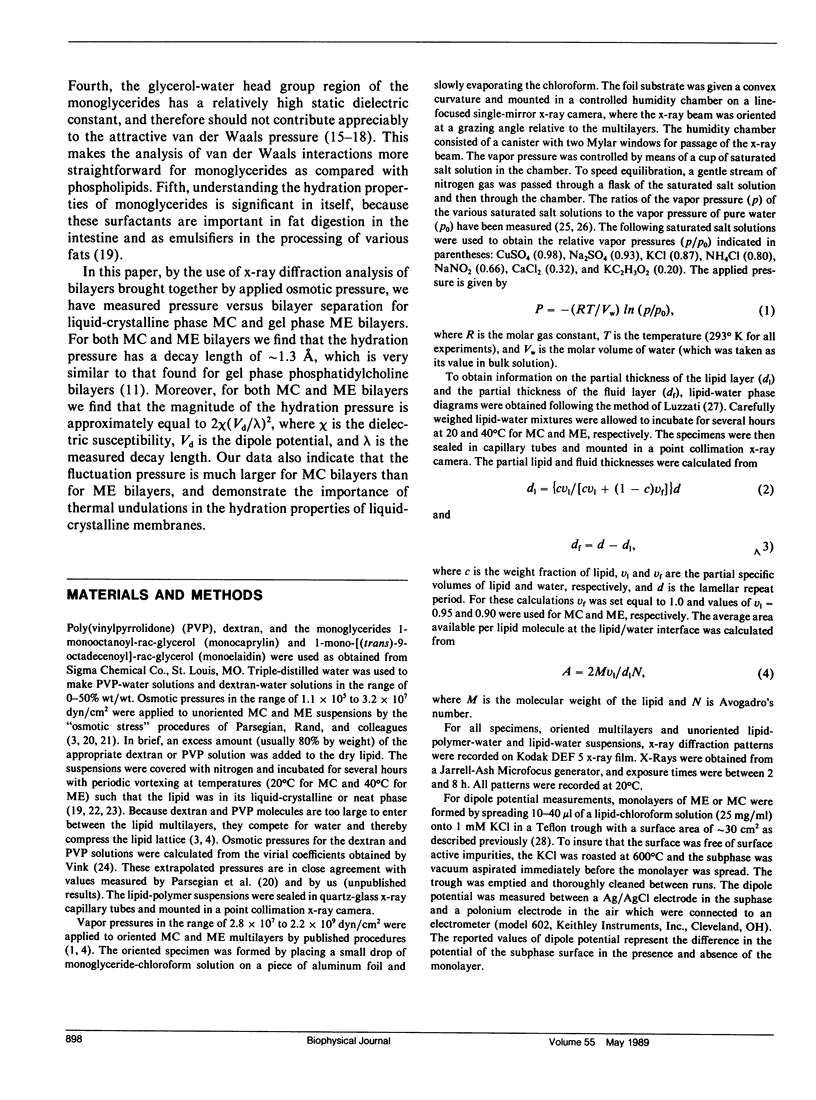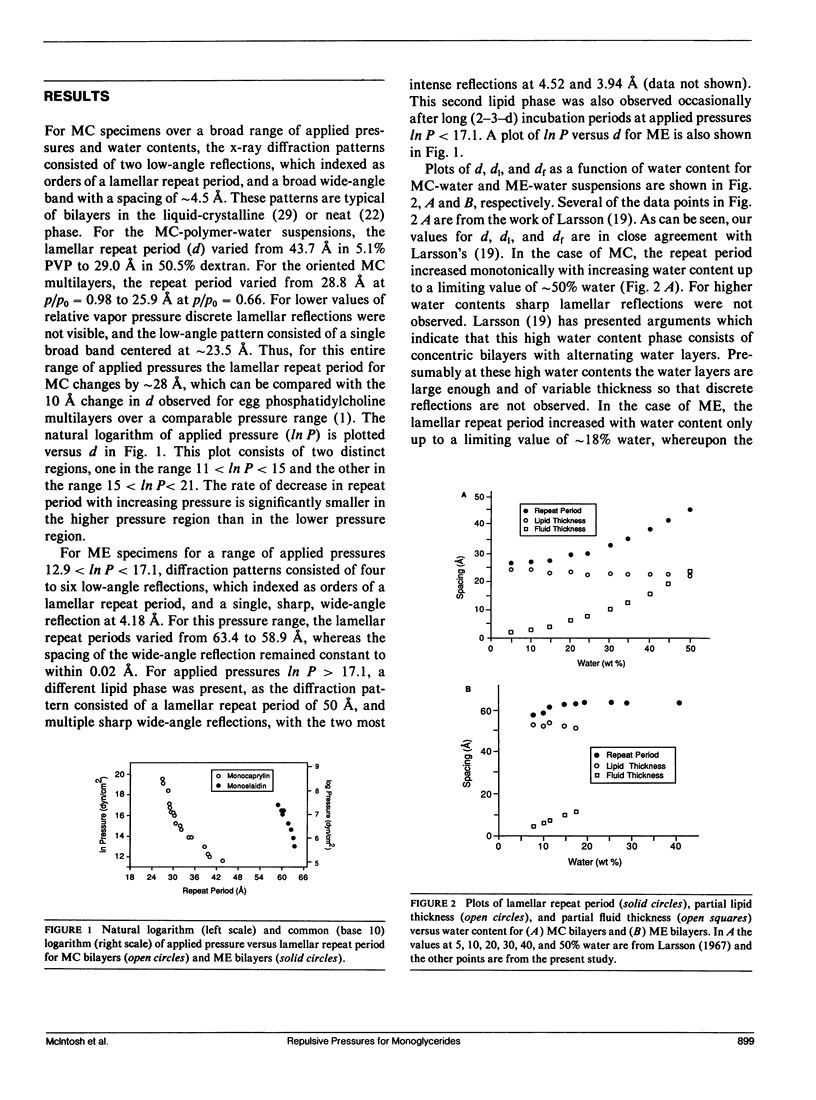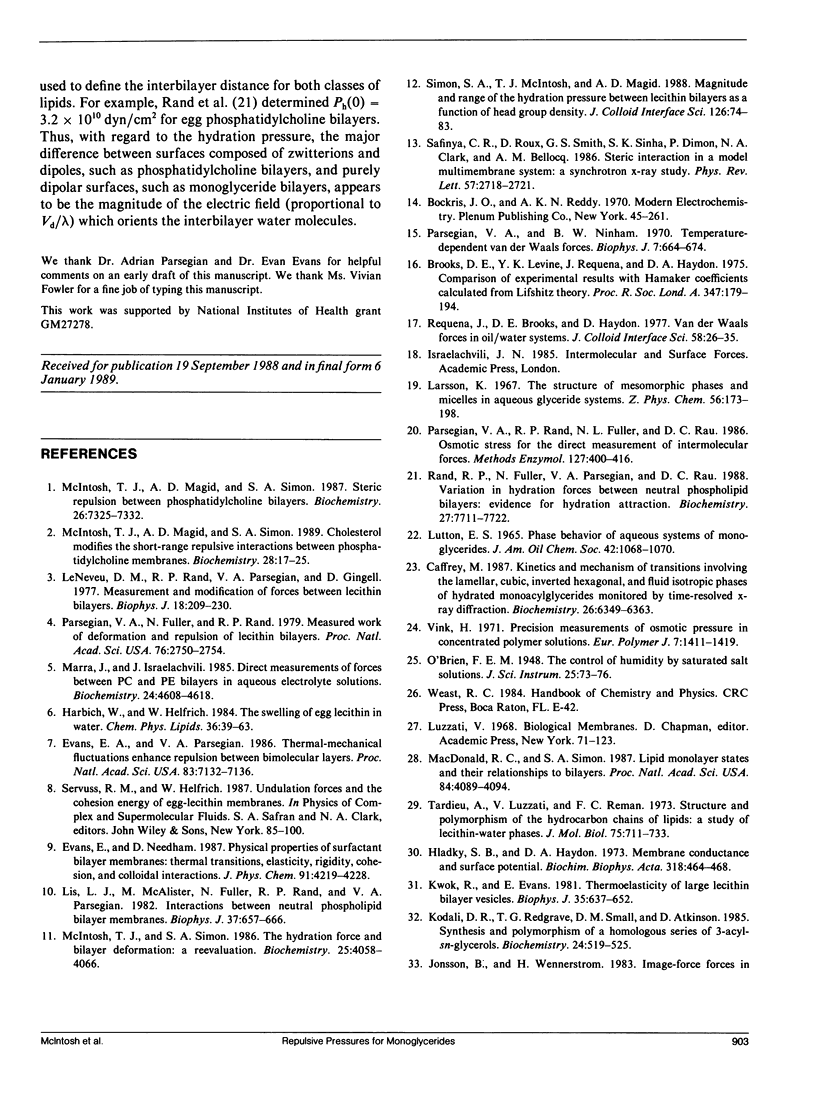Abstract
Pressure versus distance relations have been obtained for solid (gel) and neat (liquid-crystalline) phase uncharged lipid bilayers by the use of x-ray diffraction analysis of osmotically stressed monoglyceride aqueous dispersions and multilayers. For solid phase monoelaidin bilayers, the interbilayer repulsive pressure decays exponentially from a bilayer separation of approximately 7 A at an applied pressure of 3 x 10(7) dyn/cm2 to a separation of approximately 11 A at zero applied pressure, where an excess water phase forms. The decay length is approximately 1.3 A, which is similar to the value previously measured for gel phase phosphatidylcholine bilayers. This implies that the decay length of the hydration pressure does not depend critically on the presence of zwitterionic head groups in the bilayer surface. For liquid-crystalline monocaprylin, the repulsive pressure versus distance curve has two distinct regions. In the first region, for bilayer separations of approximately 3-8 A and applied pressures of 3 x 10(8) to 4 x 10(6) dyn/cm2, the pressure decays exponentially with a decay length of approximately 1.3 A. In the second region, for bilayer separations of approximately 8-22 A and applied pressures of 4 x 10(6) to 1 x 10(5) dyn/cm2, the pressure decays much more gradually and is inversely proportional to the cube of the distance between bilayers. These data imply that two repulsive pressures operate between liquid-crystalline monocaprylin bilayers, the hydration pressure, which dominates at small (3-8 A) bilayer separations, and the fluctuation pressure, which dominates at larger bilayer separations (greater than 8 A) and strongly influences the hydration properties of the liquid-crystalline bilayers. Thus, due primarily to thermally induced fluctuations, monocaprylin bilayers imbibe considerably more water than do monoelaidin bilayers. For both monoelaidin andmonocaprylin, the measured magnitude of the hydration pressure is found to be proportional to the square of the dipole potential.
Full text
PDF







Selected References
These references are in PubMed. This may not be the complete list of references from this article.
- Caffrey M. Kinetics and mechanism of transitions involving the lamellar, cubic, inverted hexagonal, and fluid isotropic phases of hydrated monoacylglycerides monitored by time-resolved X-ray diffraction. Biochemistry. 1987 Oct 6;26(20):6349–6363. doi: 10.1021/bi00394a008. [DOI] [PubMed] [Google Scholar]
- Cevc G., Marsh D. Hydration of noncharged lipid bilayer membranes. Theory and experiments with phosphatidylethanolamines. Biophys J. 1985 Jan;47(1):21–31. doi: 10.1016/S0006-3495(85)83872-8. [DOI] [PMC free article] [PubMed] [Google Scholar]
- Evans E. A., Parsegian V. A. Thermal-mechanical fluctuations enhance repulsion between bimolecular layers. Proc Natl Acad Sci U S A. 1986 Oct;83(19):7132–7136. doi: 10.1073/pnas.83.19.7132. [DOI] [PMC free article] [PubMed] [Google Scholar]
- Kodali D. R., Redgrave T. G., Small D. M., Atkinson D. Synthesis and polymorphism of 3-acyl-sn-glycerols. Biochemistry. 1985 Jan 15;24(2):519–525. doi: 10.1021/bi00323a041. [DOI] [PubMed] [Google Scholar]
- Kwok R., Evans E. Thermoelasticity of large lecithin bilayer vesicles. Biophys J. 1981 Sep;35(3):637–652. doi: 10.1016/S0006-3495(81)84817-5. [DOI] [PMC free article] [PubMed] [Google Scholar]
- LeNeveu D. M., Rand R. P. Measurement and modification of forces between lecithin bilayers. Biophys J. 1977 May;18(2):209–230. doi: 10.1016/S0006-3495(77)85608-7. [DOI] [PMC free article] [PubMed] [Google Scholar]
- Lis L. J., McAlister M., Fuller N., Rand R. P., Parsegian V. A. Interactions between neutral phospholipid bilayer membranes. Biophys J. 1982 Mar;37(3):657–665. [PMC free article] [PubMed] [Google Scholar]
- Liu N. I., Kay R. L. Redetermination of the pressure dependence of the lipid bilayer phase transition. Biochemistry. 1977 Jul 26;16(15):3484–3486. doi: 10.1021/bi00634a030. [DOI] [PubMed] [Google Scholar]
- Lorenzen S., Servuss R. M., Helfrich W. Elastic Torques about Membrane Edges: A Study of Pierced Egg Lecithin Vesicles. Biophys J. 1986 Oct;50(4):565–572. doi: 10.1016/S0006-3495(86)83496-8. [DOI] [PMC free article] [PubMed] [Google Scholar]
- Lutton E. S. Phase behavior of aqueous systems of monoglycerides. J Am Oil Chem Soc. 1965 Dec;42(12):1068–1070. doi: 10.1007/BF02636909. [DOI] [PubMed] [Google Scholar]
- MacDonald R. C., Simon S. A. Lipid monolayer states and their relationships to bilayers. Proc Natl Acad Sci U S A. 1987 Jun;84(12):4089–4093. doi: 10.1073/pnas.84.12.4089. [DOI] [PMC free article] [PubMed] [Google Scholar]
- Marra J., Israelachvili J. Direct measurements of forces between phosphatidylcholine and phosphatidylethanolamine bilayers in aqueous electrolyte solutions. Biochemistry. 1985 Aug 13;24(17):4608–4618. doi: 10.1021/bi00338a020. [DOI] [PubMed] [Google Scholar]
- McIntosh T. J., Magid A. D., Simon S. A. Cholesterol modifies the short-range repulsive interactions between phosphatidylcholine membranes. Biochemistry. 1989 Jan 10;28(1):17–25. doi: 10.1021/bi00427a004. [DOI] [PubMed] [Google Scholar]
- McIntosh T. J., Magid A. D., Simon S. A. Steric repulsion between phosphatidylcholine bilayers. Biochemistry. 1987 Nov 17;26(23):7325–7332. doi: 10.1021/bi00397a020. [DOI] [PubMed] [Google Scholar]
- McIntosh T. J., Simon S. A. Hydration force and bilayer deformation: a reevaluation. Biochemistry. 1986 Jul 15;25(14):4058–4066. doi: 10.1021/bi00362a011. [DOI] [PubMed] [Google Scholar]
- Parsegian V. A., Fuller N., Rand R. P. Measured work of deformation and repulsion of lecithin bilayers. Proc Natl Acad Sci U S A. 1979 Jun;76(6):2750–2754. doi: 10.1073/pnas.76.6.2750. [DOI] [PMC free article] [PubMed] [Google Scholar]
- Parsegian V. A., Ninham B. W. Temperature-dependent van der Waals forces. Biophys J. 1970 Jul;10(7):664–674. doi: 10.1016/S0006-3495(70)86327-5. [DOI] [PMC free article] [PubMed] [Google Scholar]
- Parsegian V. A., Rand R. P., Fuller N. L., Rau D. C. Osmotic stress for the direct measurement of intermolecular forces. Methods Enzymol. 1986;127:400–416. doi: 10.1016/0076-6879(86)27032-9. [DOI] [PubMed] [Google Scholar]
- Rand R. P., Fuller N., Parsegian V. A., Rau D. C. Variation in hydration forces between neutral phospholipid bilayers: evidence for hydration attraction. Biochemistry. 1988 Oct 4;27(20):7711–7722. doi: 10.1021/bi00420a021. [DOI] [PubMed] [Google Scholar]
- Safinya CR, Roux D, Smith GS, Sinha SK, Dimon P, Clark NA, Bellocq AM. Steric interactions in a model multimembrane system: A synchrotron x-ray study. Phys Rev Lett. 1986 Nov 24;57(21):2718–2721. doi: 10.1103/PhysRevLett.57.2718. [DOI] [PubMed] [Google Scholar]
- Seddon J. M., Harlos K., Marsh D. Metastability and polymorphism in the gel and fluid bilayer phases of dilauroylphosphatidylethanolamine. Two crystalline forms in excess water. J Biol Chem. 1983 Mar 25;258(6):3850–3854. [PubMed] [Google Scholar]
- Tardieu A., Luzzati V., Reman F. C. Structure and polymorphism of the hydrocarbon chains of lipids: a study of lecithin-water phases. J Mol Biol. 1973 Apr 25;75(4):711–733. doi: 10.1016/0022-2836(73)90303-3. [DOI] [PubMed] [Google Scholar]


